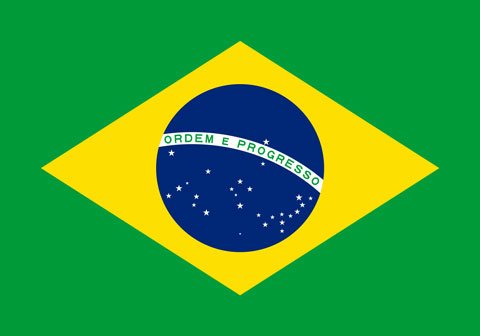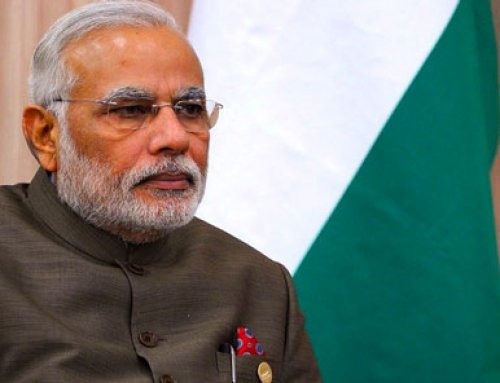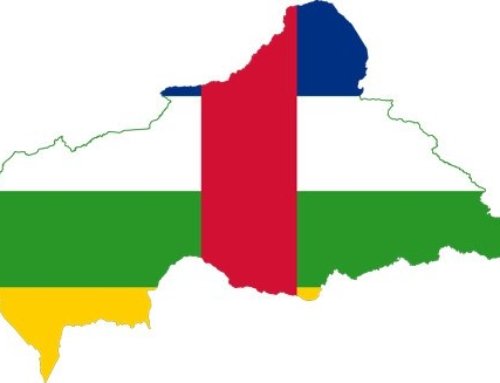While Brazil is widely known for the production of colored gemstones, it is often not recognized as a source of gem diamonds. Yet diamonds were discovered in the early 1700s by artisanal miners looking for gold along the banks of the Jequitinhonha River near the village of Arraial do Tijuco (later named Diamantina) in the state of Minas Gerais. For the next 150 years, Minas Gerais was the world’s major supplier of gem diamonds. Beginning in the early 1840s, unusual polycrystalline black diamonds (or carbonados) were also recovered, mainly from the state of Bahia.
Brazil in the 15th century
The first European explorers to reach the New World in the late 1400s were focused on finding spices and gold rather than diamonds. The Italian explorer and navigator Christopher Columbus set sail under the Spanish flag in 1492 in search of a more direct route to the “Indies,” the region of the Indian subcontinent and eastern Africa that was rich in spices, gemstones, pearls, and gold.
After a five-week westward voyage, Columbus discovered an island in the Caribbean and called it San Salvador. Portugal and Spain, the global powers of the day, understood that to avoid future confrontation, they had to subdivide the recently discovered lands in the New World. The Treaty of Tordesilhas, drawn up by Pope Alexander VI and signed by the two empires in 1494, drew a meridian that would effectively divide South America (which had yet to be discovered by Europeans) from north to south.
Spain would receive the lands west of the meridian, including modern-day Venezuela, Colombia, Ecuador, and Peru, while Portugal gained the eastern side. On his third trip to the New World in 1498, Columbus discovered the mouth of the Orinoco River in what is today Venezuela. Here was the key to reaching a vast continental interior concealed in the jungles behind the Atlantic coastline.
To open a new trade route to India that did not require passing through the Mediterranean, Portuguese nobleman Pedro Álvares Cabral was dispatched in early 1500 with a fleet of ships. His mission was to reach India by traveling south around the tip of Africa. His fleet landed instead on the coast of Brazil, which he claimed for Portugal on April 22 of that year.
The voyages of Amerigo Vespucci, the Florentine navigator after whom the continent is named, took place around the same time. As he sailed south along the Brazilian coast, Vespucci realized that the continent was much larger than previously recognized. These expeditions were the first to bring back shipments to Portugal of pau brasil (Brazilwood), a tree sought after not only for timber but for a desirable red dye. Over the next two centuries, more European adventurers came to South America, most of them seeking riches in the form of gold, silver, and emeralds.
Portugal’s role in Brazil
Between 1534 and 1536, King John III of Portugal divided the coastal regions of Brazil into 15 captaincy colonies to encourage development; these areas were given to Portuguese noblemen to administer and explore. Within a few years, most of these captaincies failed for a number of reasons. With this setback as well as the presence of French ships along the coast, the Portuguese crown decided to turn Brazil into a royal enterprise in 1549. Several successive governors-general were appointed to administer the colony, which was divided in 1621 into the states of Maranhão (in the north) and Brazil (in the south).
The exploration of Brazil’s vast interior was left to Portuguese adventurers, known as bandeirantes (flag bearers), who claimed territories for Portugal and the Catholic Church. While Spanish conquests in the New World met resistance from powerful empires—the Aztecs in Mexico and the Incas in Peru—the Portuguese were confronted with numerous small native tribes and a forbidding interior.
Exploration and conquest on both sides of the Tordesilhas meridian would soon rewrite the gemological texts of the time. For example, Spanish exploitation of emeralds in the territory of New Granada (modern-day Colombia) would vastly change the world’s understanding and appreciation for the gem, particularly in Europe. Brazil would emerge as a major source for dozens of colorful gem species. It would also become, for a period, the world’s most prolific source of diamonds.
Much of the early exploration and colonization of Brazil was undertaken by the bandeirantes. The bandeiras, funded by the crown and the Catholic Church, were large quasi-military expeditions comprised of hundreds of free men and slaves who ventured into the interior, capturing and enslaving indigenous groups they encountered.
Along with a Jesuit priest, explorer Francisco Bruzo Espinoza mounted the first bandeira in 1554, in search of emerald. It was a short-lived and fruitless expedition. Successive expeditions also failed, though in 1572 Sebastião Fernandes Tourinho found green and blue gems (likely tourmaline) along the tributaries of the Jequitinhonha and Doce Rivers in what is now Minas Gerais. The success of Tourinho’s discoveries attracted more adventurers.
In 1695, at Rio das Velhas, Manuel Borba Gato finally discovered gold, triggering a rush that would lead to the settlement of Vila Rica (later Ouro Preto) in 1698. The town played a leading role in Brazilian history for the next two centuries as the capital of Minas Gerais from 1720 to 1897. Settlements at Mariana, São Bento, Serro Frio, and Arraial do Tijuco soon followed the gold discoveries in those areas of Minas Gerais, and dozens more sprang up in Brazil’s interior.
The north-south road system in Minas Gerais, known as the Estrada Real or “royal highway,” begun in 1697, was built to promote trade, economic development, and communication. Minerals, wood, and other natural resources were transported along the road from the interior to the coast for shipment to Lisbon. Manufactured goods from Portugal were also carried inland. The road was strictly regulated by the crown to prevent smuggling and unauthorized movement of goods. It was also the only official route for traveling inland.
As Brazil’s population grew from European settlement, larger farms were required to grow crops, and indigenous tribes were used as a source of slave labor. Slaves were also imported from Portugal’s African colonies to work the farms. The combination of slave labor and the colony’s immense wealth of minerals and wood provided Portugal with unique imports for the European market .
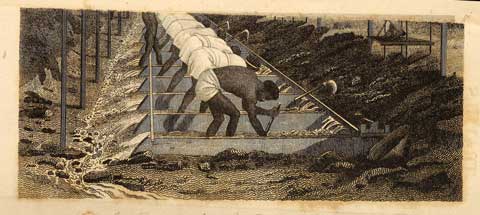
Early reports on diamonds from Brazil
Early indications of Brazil’s diamond potential were sporadic, but there is evidence that crystals were found in Bahia within a century of Columbus’s discovery of the New World. In one of the earliest descriptions, historian Pero de Magalhães Gândavo (1576) mentioned the existence of “certain mines of white stones such as diamonds.” In another account, Gabriel Soares de Sousa (1587) noted that fine, eight-sided crystals—possibly diamond—had been found during the dry winter months along certain rivers.
English adventurer Anthony Knivet, who was captured and later escaped during a raid of Portuguese settlements in southern Brazil led by the English privateer Thomas Cavendish, described seeing what he believed to be diamond crystals while living among the natives in the late 1590s. This would have been another of the earliest accounts of Brazilian diamonds, though no details were provided and the crystals could have been other gems such as quartz.
In 1695, gold was discovered in the mountainous region near Ouro Preto, and over the following decade thousands of miners flocked from the coast to the interior in search of the precious metal.
Near the village of Arraial do Tijuco in the northern part of Minas Gerais, unusually bright transparent crystals kept showing up in the panned river gravels in the early 1700s. In some cases, the miners disregarded them. Dos Santos recalled that men sometimes used these crystals as small markers in card games. A similar account says that in 1721 a gold miner secured several of these markers, which were later recognized as diamonds by someone who had traveled in the Golconda region of India.
The discovery of Brazilian diamonds is supported by the account of the Dutch explorer Jacob Roggeven (or Roggewein). As reported in Kerr, Roggeven’s three ships anchored off the coast near São Paulo for a short time in November 1721 before resuming their voyage to the Pacific Ocean. Several crewmembers deserted to go to the diamond mining area:
A little time before the arrival of Roggewein, the Portuguese had discovered a diamond mine not far from St Sebastian, of which at that time they were not in full possession, but were meditating an expedition against the Indians, in order to become sole masters of so valuable a prize; and with this view they invited the Dutch to join them, promising them a share in the riches in the event of success. By these means, nine of our soldiers were tempted to desert. I know not the success of this expedition; but it is probable that it succeeded, as great quantities of diamonds have since been imported from Brazil into Europe. They are said to be found on the tops of mountains among a peculiar red earth containing a great deal of gold; and, being washed down by the great rains and torrents into the vallies, are there gathered.
Eventually, reports of diamonds in Minas Gerais began to reach Europe. Accounts from the colonial governor came to the attention of both King John V and the Catholic Church in Portugal, and the discovery was officially announced in 1729. As Lisbon’s economic clout in Europe had waned somewhat, this was welcome news.
In Minas Gerais, there was a diamond rush in the many rivers and streams around Arraial do Tijuco. Portugal moved aggressively to control the area, restricting gold and diamond mining and imposing high taxes. Despite efforts by the crown, clandestine mining and diamond smuggling increased. Draper noted:
The diamonds played a prominent part in shaping the destiny of Portugal. Wealth derived from its diamonds not only helped place that country at the zenith of its glory but also contributed, at a later stage, to its release from the French occupation by paying part of the indemnity exacted by France during the Napoleonic wars (1807-1814).
The occurrence of alluvial diamonds around Arraial do Tijuco was reported in the scientific literature by de Castro Sarmento. Over time, Arraial do Tijuco became the town of Diamantina, the diamond trading center during Brazil’s tenure as the world’s leading exporter. To properly dredge, reroute, and mine the rivers around Diamantina required hard manual labor. This need coincided with the growth of the sugarcane business in Brazil’s northeast, and slaves were imported from modern-day Angola, Congo, and Mozambique to fill the needs of both industries. Much like Ouro Preto, Diamantina grew into a rich and picturesque city in the 18th and 19th centuries.
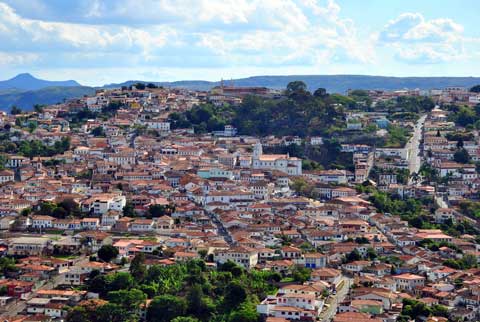
42,000 carats per year from Brazil to Europe
Oakenfull reported that between 1732 and 1771, “at least 1,666,500 carats of diamonds were exported to Europe.” That figure represents an average of about 42,000 carats per year.
While miniscule by today’s standards, it placed Brazil squarely as the world’s top diamond producer at the time, eclipsing India’s Golconda region. The glut of Brazilian diamonds pouring into Europe caused a steep decline in prices for a time. Consequently, there were efforts to protect the value of the Indian diamonds on the market by disparaging the quality of Brazilian diamonds.
Oversupply was put to an end in 1739 when Portugal stepped in to monopolize the Brazilian mines, but by then the Golconda mines had stopped producing. An arrangement with financiers in Amsterdam ensured a steady supply of Brazilian rough for the city’s diamond cutters. And despite Portuguese oversight, smuggled Brazilian diamonds also found their way to London, another major center for rough diamonds and jewelry production.
During this period, additional alluvial sources were discovered. Diamonds were found in the Mato Grosso region in 1746, and subsequently in other rivers in Minas Gerais. The Jequitinhonha River near Diamantina and the surrounding area yielded impressive quantities of alluvial diamonds as well (figure 8), including treasure troves in “potholes” or traps in the river bedrock. But the primary source of diamonds in Minas Gerais—actual diamondiferous kimberlites—remains elusive. As Sinkankas noted:
The original host rocks of the diamond crystals remain unknown despite much past speculation, “proof” of host rock sources by some authorities, and modern intensive geologic exploration of the regions presently yielding diamonds. Brazilian diamonds are found in a sort of matrix to be sure, this being a conglomerate of well-rounded pebbles cemented together with sand and iron oxides.
In 1733, Portuguese authorities began granting royal licenses to individuals to work portions of the diamond deposits. Guarded mule trains transported the diamonds along the Estrada Real to Parati and Rio de Janeiro. This licensing system eventually broke down, as bands of runaway slaves and garimpeiros clandestinely worked the areas or stole the recovered diamonds. In 1772, the government abandoned this system and took full control of the workings around Diamantina.
The English mineralogist John Mawe is probably the most celebrated European traveler to Brazil’s interior, having been the first foreigner to reach the diamond mines. In 1809 he received approval and funding from the Portuguese crown for his visit. His descriptions of the diamond region are still some of the most detailed. A vivid portrayal of the washing plants and the diamond discovery methods emerges in his 1812 account, Travels in the Interior of Brazil:
A shed is erected in the form of a parallelogram…consisting of upright posts which support a roof thatched with long grass. Down the middle of the area of this shed a current of water is conveyed through a canal covered with strong planks, on which the cascalhão
Mawe’s successful journey prompted other European explorers to follow in his footsteps. His account, and the illustrations in his book by noted mineralogist James Sowerby, inspired many European scientists from a variety of disciplines to explore Brazil. Swiss botanist Auguste de Saint-Hilaire, who traveled there in 1817, described Diamantina as a “valley of diamonds”. He also painted a dismal image of the conditions for both the garimpeiros and slaves around Diamantina. The slaves received little food or rest, and their panning and sorting of diamonds was subject to strict punishment. The only reprieve was good luck:
From this wretched mode of life a fortunate accident sometimes frees a slave. When he happens to find a diamond weighing an octavo, or 17 ½ carats… his value is ascertained by the administration, the price is paid to his owner, he is dressed, and set at liberty.
German nobleman Baron Wilhelm Ludwig von Eschwege fought alongside the Portuguese during the Napoleonic Wars, and for his service he was granted access to Minas Gerais as a consultant for the government. In 1811, he settled in Ouro Preto to lend his qualifications there as a mining engineer. Having traveled throughout Minas Gerais over the course of a decade, he was instrumental in not only documenting existing techniques used for diamond and gold mining, but also offering recommendations for the use of more modern procedures.
Richard Francis Burton, an English explorer, was noted for his travel in sub-Saharan Africa in search of the origins of the Nile River as well as other exploits in the 1850s. In 1865, he was given a diplomatic post in Brazil by the British government. An 1867 expedition in the Brazilian highlands took him to Diamantina and the São Francisco River. His account of reaching the city, and his description of the diamond mining region, are well chronicled in his 1869 book, Explorations of the Highlands of Brazil.
When Brazil gained independence in 1822, Portuguese control of diamond mining ceased in Minas Gerais. It was replaced with a system of free exploitation except along the Jequitinhonha River Valley, which remained under some government control until 1845. By the 1880s, production had dropped significantly due to several factors—the low grade of the alluvial deposits, competition from diamonds from South Africa, and Brazil’s abolition of slavery in 1888, which meant the loss of cheap labor.
Conclusion on Brazil as a diamond producer
Brazil’s significance as a diamond producer spans three centuries, making it the world’s longest continuous commercial source of diamonds. Brazil reached its peak production in the mid-1700s as adventurers and explorers made their way into the country’s vast interior. Most of its diamond supply—then and now—comes from the multitude of alluvial sources spread across the country.
Alluvial diamonds have been mined in most Brazilian states since the beginning of the 18th century, when the colony was still under Portuguese rule. Besides alluvial occurrences, there are other important deposits related to conglomerates (Romaria, Minas Gerais), glacial rocks (Tibagi, Paraná), and mid-Paleozoic metasedimentary rocks (Diamantina District, Minas Gerais and Chapada Diamantina, Bahia). Among the alluvial deposits, the Coromandel and Abaeté regions have occasionally yielded “megadiamonds” reaching hundreds of carats in size, as well as crystals with pink, yellow, green, red, and blue “fancy colors.” The mines of the Juína region in Mato Grosso are known for the quantity of their production.
Although systematic exploration of Brazilian kimberlites began relatively late, there are several known mineralized bodies in the states of Minas Gerais, Bahia, Mato Grosso, Rondônia, Goiás, and Piauí. Large mining groups such as De Beers have worked in Brazil but never at a reported kimberlite source. However, more than 1,300 kimberlite pipes have been identified through exploration in the last century.
The past three centuries have shown the importance of mining to Brazil’s economic development. Since the beginning, garimpeiros have worked the remote regions, founding towns that later became cities such as Diamantina, Coromandel, and Juína. In the ongoing search for new mineral deposits, the garimpeiros pushed west beyond the boundaries of the Treaty of Tordesilhas, helping expand Brazilian territory. Beginning in the 1700 and 1800s, Brazilian diamonds were used in European jewelry—the larger and better-quality diamonds found their way into royal jewelry collections at a time when production from India had ceased and the African deposits had yet to be discovered.
Another important development was the discovery of carbonado in Chapada Diamantina in the 1840s. In the early 1990s, sublithospheric diamonds were discovered in the kimberlites of Juína in Mato Grosso. These unusual diamonds contain inclusions of minerals formed in the transition zone and lower mantle. Their study has increased our awareness of the mineralogy of Earth’s interior.
Brazil’s diamond production remains enigmatic. The country’s enormous expanse, and the fact that diamonds have been found at numerous alluvial sources, weathered over the millennia from their primary sources and dispersed throughout the continent in riverbeds and conglomerates, contributes to the confusion. A lack of expertise in large-scale diamond mining, and industry regulation, have also hampered growth in the sector. According to Constance, recent production has stalled for several reasons: government efforts to comply with the Kimberley Process Certification Scheme, its crackdown in 2006 on diamond smuggling, and the 2008 global financial crisis. When combined with the shortage of skilled labor and the limited availability of geological resources that can be applied to mineral exploration, an expanded diamond mining program seems unlikely in the near future.
However, Brazil’s diamond production may yet be rewritten in the early 21st century. Despite considerable geological fieldwork, the sources of most alluvial diamonds in Brazil are still uncertain. As large-scale mining will be conducted in at least one location, the traditional scene of garimpeiros panning for alluvial diamonds likely represents a vanishing way of life.


